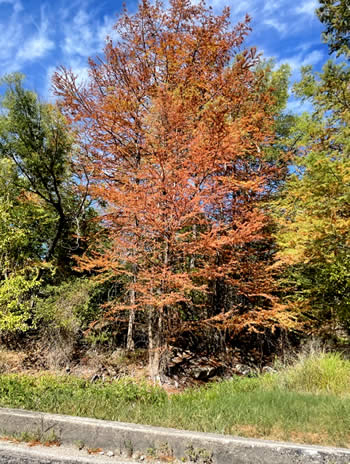
August 8, 2022 - Over 99% of Texas is under drought conditions, creating negative impacts to our landscape – especially to trees. With no end in sight, how do we protect our trees under extreme heat and dry conditions?
The most important thing you can do for your trees is water – which can be a challenge when trying to conserve the necessary resource.
“We are starting to see widespread drought stress in trees across the state,” said Karl Flocke, Texas A&M Forest Service Woodland Ecologist. “At this point, we are even seeing some trees starting to die because of stress.”
Dying trees are generally in isolated pockets where the soil is dry and not holding much water, or in parts of the state where there has been an extended period without rain.
“Several different species are dying and declining rapidly,” said Flocke. “But generally, we are seeing the most drought-induced mortality on oaks, a few elm trees, hackberry trees and even some junipers.”
The best thing we can do to slow mortality rates in trees is water them, and consistently. Consistent watering is crucial for trees because there is no water storage system within them. Most of the water taken up by trees is not held in the trees but instead is returned to the atmosphere in a process called transpiration.
“You think about a cactus and how it’s filled with water for later use,” said Flocke. “Trees are not like that; they are not filled with water. Trees are constantly getting water from the soil and releasing it back in the atmosphere through transpiration.”
Due to the lack of a water storage system within trees, they need watering regularly to survive.
As the drought continues, though, many counties, cities and water districts have begun putting water restrictions in place to conserve the precious resource.
“When most of us turn on a hose, the water that comes out was either pumped from an underground aquifer or it came from a surface source such as a lake,” said Flocke. “This resource is limited and is necessary to support the life of not only fish and wildlife, but humans as well.”
During extreme drought, using water in our landscape for trees and yards can reduce the amount of water available in aquifers, rivers and lakes.
“This same water is needed to sustain wildlife, grow food, cool power plants and fight wildfires,” said Flocke.
So, how can you best take care of your trees while conserving water resources?
First, well-established trees that are not showing signs of heat stress do not need to be watered. Signs of stress to look for include dropping or wilting leaves, small or malformed leaves, yellowing of the leaves and browning tips of the leaves.
Younger trees that have been planted in the landscape in the last few years, though, should be watered consistently.
Next, it’s important to prioritize the trees that you want to maintain in your landscape. Keeping shade trees alive that add incomparable value when it comes to lowering temperatures around your home should be the first priority.
“It’s important to prioritize keeping a healthy tree canopy, especially around residential areas,” said Flocke. “Really, focusing on the trees that have significance to you for either shade, beauty or emotional meaning.”
In a typical summer, watering young trees with two to three gallons per inch of trunk diameter, two to three times per week is a good rule of thumb. However, make sure the soil is never saturated with water.
When under water restrictions and drought conditions, though, the goal shifts to keeping your trees alive until conditions change, rather than forcing them into a growing stage, which requires more energy. In extreme drought, trees can survive on half the recommended water – one to two gallons per inch of trunk diameter, once a week.
When watering your trees, there are many techniques and practices to help limit water waste and increase water retention:
- Water in the morning or evening when there will be less loss to evaporation.
- Reduce overhead watering by using a hose, bubbler or drip system instead of a sprinkler.
- Avoid chemical fertilizers as these increase the demand for water. Instead, use compost to improve oxygen and water availability.
- Use mulch over the critical root zone. Two to three inches of mulch under the canopy of the tree helps to reduce moisture loss and the drying effects of wind. Avoid placing the mulch in contact with the trunk.
- Re-use shower, bath and cooking water; just capture the water in a bucket or other container.
- Check your irrigation systems for leaks.
- Let your lawn grow taller. Shade from longer grass helps to reduce the soil temperature and the amount of water lost due to evaporation.
- Avoid pruning activities. Pruning of live tissue causes trees to expend energy to seal over the wounds. That energy could be better used to overcome drought stress.
- Avoid disrupting the soil under and around the drip line or canopy of the tree. Root disturbance and compaction reduces the ability of the tree to absorb and transport water.
- Avoid digging holes in an effort to water more deeply as this will dry out the soil in a tree’s root zone.
Some trees are also beginning to see secondary pests and diseases, or stressors. Secondary pests and diseases are those that attack a tree that is already stressed by something else, such as a drought or a winter storm. These stressors should not be what is treated this summer.
“This summer, the root cause of the issues we are seeing is the dry conditions and extreme heat,” said Flocke. “We might be seeing that represented as the tree becomes stressed by other issues, such as insect attacks or fungus forming on the tree, but really, the root cause is drought and heat stress and that is what we need to address in order to keep the trees healthy, not the insects or fungus that are secondary.”
While we won’t know the extent of the impact the drought is going to have on the state’s tree canopy until it’s over, chances are it will get worse before it gets better. So, for now, prioritize your trees for significance and value, and try to water them as conservatively as possible while we endure this Texas drought.
For additional information on caring for trees during drought conditions, visit https://tfsweb.tamu.edu/afterthestorm/Drought/.
Stay informed on drought conditions in your area by visiting https://tfsfrd.tamu.edu/ForestDrought/.









